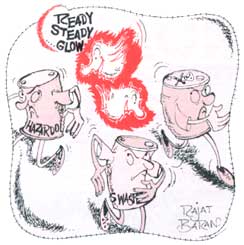Glowfriends
 IT is easy to dump waste in deep-ocean trenches - far harder to check that it has not seeped from its containers into the sea. Now, though, colonies of glowing bacteria offer some hope. When they sense pollution in the water around them, they get dimmer.
IT is easy to dump waste in deep-ocean trenches - far harder to check that it has not seeped from its containers into the sea. Now, though, colonies of glowing bacteria offer some hope. When they sense pollution in the water around them, they get dimmer.
"Our idea is that it's like a deep-sea canary," says William Jones, head of the team developing the biosensor at the University of Maryland Biotechnology Institute, USA. "If light starts to drop, it would trigger neighbouring samplers into action."
Working with colleagues at the institute and at the us Naval Research Laboratory in Washington, Jones has screened 10 species of luminous bacteria from fish and other marine creatures, mostly mammals. One of the most promising is Photobacterium phosphoreum (P phosphoreum)HE-1a, isolated from the deep-sea fish Paratrachichthys prosthemius. In a laboratory pressure chamber, the bacteria survived pressures up to 31 megapascals - equivalent to a depth of around 30,000 metres. The researchers found that P phosphoreum HE-1a glowed up to 50 per cent less brightly when exposed to a variety of potential pollutants. These included the usual heavy metals such as zinc, copper and cobait, as well as other chemical pollutants, including pesticides, polychlorinated biphenyls (PCUS) polyaromatic hydrocarbons typically found in oily wastes.
"HE-la seemed to be the most robust and to respond to almost everything," says Jones. It would not distinguish one pollutant from the other, however. Its task would be simply to issue an "alarm call" that would trigger more sophisticated sensors stationed nearby. Jones and other collaborators at the university's Center of Marine Biotechnology have built a prototype cell that exposes a living colony of the bacteria to seawater samples filtered through a semipermeable membrane. A digital camera monitors the intensity of light coming from the colony. When the cell is deployed on the seafloor, any dimming of the usual signal can alert neighbouring sensors or samplers. The signals could be monitored remotely on land or on a ship or rig.
To keep the colony alive, the bacteria will need to be fed from a buoy or platform on the surface, from which nutrients could be pumped down at a constant rate. Dead or ageing bacteria would be continuously jettisoned to keep the colony fresh.
"It's a chemostat that keeps the bugs alive," says Jones. He says the sentinel could provide a useful tool for evaluating whether proposals for deep-sea dumping would be as environmentally benign as their advocates claim.
(ones and his colleagues presented their preliminary findings recently in Atlanta at the annual meeting of the American Society for Microbiology. Their development highlights growing interest in the use of luminous bacteria as sensors. In May this year, researchers at Britain's chemical and biological defence laboratory at Porton Down, Wiltshire, UK, reported that glowing bacteria could be used to detect the use of chemical weapons.
